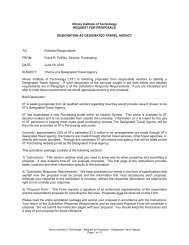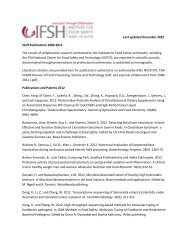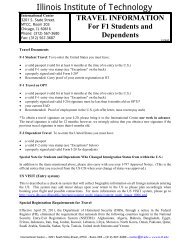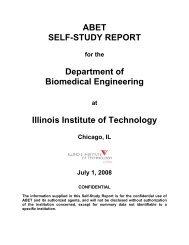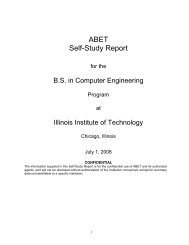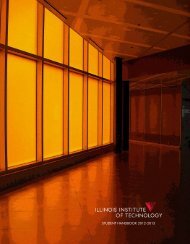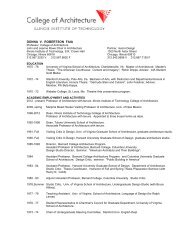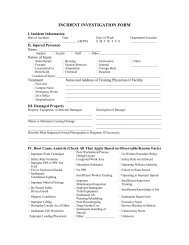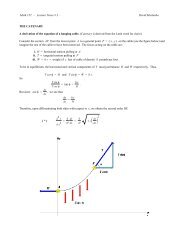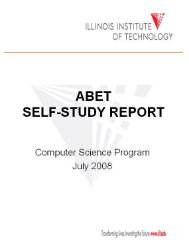Copyright & Disclaimer Information - Illinois Institute of Technology
Copyright & Disclaimer Information - Illinois Institute of Technology
Copyright & Disclaimer Information - Illinois Institute of Technology
Create successful ePaper yourself
Turn your PDF publications into a flip-book with our unique Google optimized e-Paper software.
<strong>Illinois</strong> <strong>Institute</strong> <strong>of</strong> <strong>Technology</strong><br />
ECE 383<br />
Electric and Electronic Circuits<br />
Circuit concepts, Ohm’s Law.<br />
Kirchh<strong>of</strong>f’s Laws, network theorems.<br />
Circuit elements, DC and AC network<br />
analysis. Diodes, transistors and electronic<br />
amplifiers. Digital electronics<br />
circuits and instrumentation. Credit for<br />
this course not applicable to a<br />
B.S.E.E. or a B.S.CP.E. degree and will<br />
not count in the EE or CPE major<br />
GPA. Prerequisite: PHYS 221. (3-0-3)<br />
ECE 403<br />
Communication Systems I<br />
Power spectral density. Analysis and<br />
design <strong>of</strong> amplitude and frequency<br />
modulation systems. Signal-to-noise<br />
ratio analysis. Frequency division multiplexing:<br />
spectral design considerations.<br />
The sampling theorem. Analog and<br />
digital pulse modulation systems. Time<br />
division multiplexing. Design for spectral<br />
efficiency and crosstalk control.<br />
Introduction to information theory.<br />
Prerequisite: ECE 308. (3-0-3) (P)<br />
ECE 404<br />
Communication Systems II<br />
Lecture portion <strong>of</strong> ECE 406. Credit<br />
will be given for either ECE 404<br />
or ECE 406, but not for both.<br />
Prerequisites: ECE 403 and ECE 475;<br />
or MATH 475. (3-0-3) (P)<br />
ECE 406<br />
Digital and Data Communications<br />
Channel capacity, entropy, digital<br />
source encoding considering bit rate<br />
reduction, quantization, waveshaping,<br />
and intersymbol interference. Analysis<br />
and design <strong>of</strong> digital modulators and<br />
detectors. Matched filters. Probability<br />
<strong>of</strong> error analysis. Laboratory covers<br />
modulation, detection, sampling,<br />
analog-to-digital conversion, error<br />
detection, and an open-ended project.<br />
Credit will be given for either ECE 404<br />
or ECE 406, but not for both.<br />
Prerequisites: ECE 403 and ECE 475<br />
or MATH 475. (3-3-4) (P) (C)<br />
ECE 497<br />
Computer Communications<br />
Systems<br />
The ISO-OSI layered architecture,<br />
packet switching and circuit switching,<br />
error detection and recovery (ARQ)<br />
protocols, bridges and routers, basic<br />
queueing theory, telephone switches,<br />
<strong>Copyright</strong> & <strong>Disclaimer</strong> <strong>Information</strong>: <strong>Copyright</strong> © 1994, 1995, 1996, 1997, 1998, 1999, 2000, 2001, 2002, 2003, 2004, 2005, 2006, 2007. CollegeSource®, Inc. and Career Guidance Foundation. CollegeSource® digital catalogs are derivative works owned and copyrighted by CollegeSource®, Inc. and Career Guidance Foundation. Catalog content is owned and copyrighted by the appropriate school. While CollegeSource®, Inc. and Career Guidance Foundation provides information as a service to the public, copyright is retained on all digital catalogs.<br />
<strong>Copyright</strong> & <strong>Disclaimer</strong> <strong>Information</strong>: <strong>Copyright</strong> © 1994, 1995, 1996, 1997, 1998, 1999, 2000, 2001, 2002, 2003, 2004, 2005, 2006, 2007. CollegeSource®, Inc. and Career Guidance Foundation. CollegeSource® digital catalogs are derivative works owned and copyrighted by CollegeSource®, Inc. and Career Guidance Foundation. Catalog content is owned and copyrighted by the appropriate school. While CollegeSource®, Inc. and Career Guidance Foundation provides information as a service to the public, copyright is retained on all digital catalogs.<br />
Erlang-B and Erlang-C blocking formulae,<br />
TCP/IP, X.25, signaling (Signaling<br />
System 7), Personal Communication<br />
Services (PCS) networks, Broadband<br />
Networks. Prerequisite: ECE 475 or<br />
MATH 475. (3-0-3) (P) (C)<br />
ECE 409<br />
Communication Electronics<br />
Radio frequency AM, FM and PM<br />
transmitter and receiver principles.<br />
Design <strong>of</strong> mixers, oscillators,<br />
impedance matching networks, filters,<br />
phase-locked loops, tuned amplifiers,<br />
power amplifiers, and crystal circuits.<br />
Nonlinear effects, intermodulation<br />
distortion and noise. Transmitter and<br />
receiver design specifications.<br />
Laboratory experiments reinforce<br />
concepts and include an open-ended<br />
design problem. Prerequisites: ECE<br />
309, ECE 312. Corequisite: ECE 403.<br />
(3-3-4) (P) (C)<br />
ECE 410<br />
Consumer Electronics<br />
<strong>Information</strong> acquisition and signal<br />
processing techniques utilized in communication<br />
systems with emphasis on<br />
implementation in television. Topics<br />
covered include synchronization, surface<br />
acoustic wave filters, ultrasonic transducers,<br />
frequency-band utilization,<br />
calorimetry, color encoding and decoding.<br />
Prerequisites: ECE 308, ECE 312.<br />
(3-0-3) (P)<br />
ECE 411 ECE 419<br />
Power Electronics<br />
Analysis, design and application <strong>of</strong> electronic<br />
devices to power and control<br />
systems. Control <strong>of</strong> AC-DC, DC-AC,<br />
DC-DC, AC-AC converters, motor<br />
speed, and switched-mode power<br />
supplies using devices such as power<br />
transistors, power MOSFETs, FETs,<br />
thyristors (SCRs), GTOs, IGBTs and<br />
UJTs. Project laboratory emphasizes<br />
power electronic circuit analysis, design<br />
<strong>of</strong> converters, and design and control<br />
<strong>of</strong> devices and their cost/performance<br />
trade<strong>of</strong>fs. Prerequisites: ECE 312, ECE<br />
319. (3-3-4) (P) (C)<br />
ECE 413<br />
Modern Optics and Lasers<br />
Geometrical and physical optics.<br />
Interference, diffraction, and polarization.<br />
Coherence and holography. Light<br />
emission and absorption. Principles<br />
Course Descriptions<br />
<strong>of</strong> laser action, characterization <strong>of</strong><br />
lasers and laser applications. Same as<br />
PHYS 412. Prerequisite: PHYS 348.<br />
(3-0-3)<br />
ECE 414<br />
Audio and Electroacoustics<br />
Analysis and design <strong>of</strong> audio preamplifiers,<br />
power amplifiers, passive and<br />
active filters. Acoustic principles. Basics<br />
<strong>of</strong> magnetic recording. Project laboratory:<br />
the design, construction, troubleshooting<br />
and testing <strong>of</strong> components<br />
<strong>of</strong> an audio system. Prerequisite:<br />
ECE 312. (3-3-4) (P) (C)<br />
ECE 415<br />
Solid State Electronics<br />
Energy-bands and carrier transport in<br />
semiconductors and metals. Physical<br />
principles <strong>of</strong> p-n junction devices,<br />
bipolar junction transistors, FETs,<br />
Gunn diodes, IMPATT devices, lightemitting<br />
diodes, semiconductor lasers.<br />
Same as PHYS 415. Prerequisite:<br />
PHYS 348. (3-0-3) (P)<br />
ECE 418<br />
Introduction to Lasers<br />
Nature <strong>of</strong> light. Coherence and holography.<br />
Light emission and absorption.<br />
Principles <strong>of</strong> laser action. Characteristics<br />
<strong>of</strong> gas lasers, organic dye lasers, solid state<br />
lasers. Laser applications. Same as<br />
PHYS 418. Prerequisite: PHYS 348.<br />
(3-0-3)<br />
Power Systems Analysis<br />
Transmission systems analysis and<br />
design. Large scale network analysis<br />
using Newton-Raphson load flow.<br />
Economic operation <strong>of</strong> power systems<br />
with consideration <strong>of</strong> transmission<br />
losses. Unsymmetrical short-circuit<br />
studies. Detailed consideration <strong>of</strong> the<br />
swing equation and the equal-area criterion<br />
for power system stability studies.<br />
Design <strong>of</strong> electric utility power systems<br />
using interactive graphical s<strong>of</strong>tware.<br />
Prerequisite: ECE 3 19. (3-0-3) (P)<br />
ECE 420<br />
Analytical Methods<br />
in Power Systems<br />
Fundamentals <strong>of</strong> power systems operation<br />
and planning, power system<br />
dynamics and control. Design <strong>of</strong> reliable<br />
power systems, power systems security<br />
analysis, optimal scheduling <strong>of</strong> power<br />
IIT Undergraduate Bulletin 1999-2001 135



